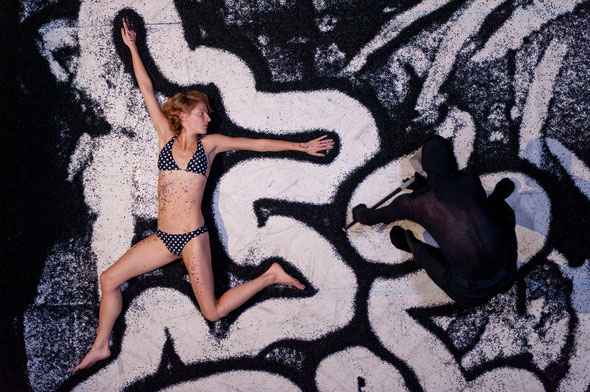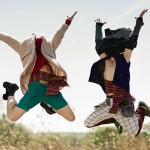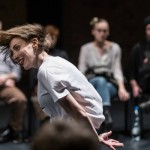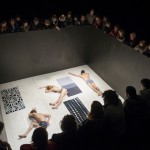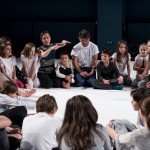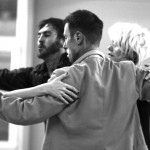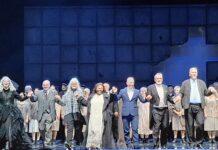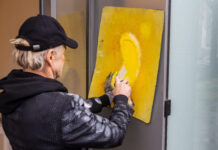The fifth edition of the international Into-The-Fields dance festival invites audiences to new visions and experience exchanges with acclaimed choreographers and emerging artists. From February 18 to March 19, the Theater im Ballsaal, the Brotfabrik and the Künstlerforum Bonn will host a wide range of dance activities, from extraordinary performances, live art and installations to workshops, artist talks and work-in-progress presentations.
The festival program offers unique field trips to the world of contemporary dance and new perspectives on movements and bodies.
“The ten selected choreographers represent some of the best today’s dance world is producing. They are challenging the traditional allocation of roles and space –the spectators on one side, the performers on other one– and engaging the audience in new ways to create a shared sensory experience,” says Rainald Endraβ, festival organizer and co-founder of Bonn-based CocoonDance Company.
Featured performers include the Hungarian dance duo Jozsef Trefeli and Gabor Varga, who are deconstructing and recycling traditional folklore dances to produce their own “Creature” with playful ferocity and vibrant body percussion (Feb. 27), and Karel Vaněk and the premiere of his new dance theatre, “Die Sehnsucht der Maybrit Illner” , inspired by German talk show host Maybrit Illner (Mar. 17/18/19).
Endraβ is excited that British dance artist Lucy Suggate, whose piece “Pilgrim” was one the highlights of last year’s Solo Festival, returns to Bonn to show her “Swarm Sculpures” at the Künstlerforum (Feb. 20 /21). Made of moving human bodies, these sculptures will be presented in galleries in Great Britain throughout summer and fall as a part of the European “Dancing Museums” project. Suggate will develop the live art work at the festival during a 2-day workshop with 30 professional and non-professional dancers.
The Into-the-Fields festival opened on Thursday with CocoonDance’s newest production, “What about Orfeo?” (Feb. 17/18/19), a collaborative work with Brazilian choreographer Cristian Duarte based on the ancient Orpheus myth. The piece takes a deeper look into narcissism, voyeurism and desire. The outcome is a clever mind game of countless reflections and reflecting mirrors. Sitting with the back to the stage, the audience takes the role of Orpheus who is forbidden to look back at his beloved wife Eurydice while walking back to the upper world. The spectators are watching the performance through big wall and small hand mirrors, which allows them to individually zoom into a scene, as in a movie, and make direct eye-contact with the dancers. Everyone has a different viewing experience and becomes part of the creative process.
Cologne dance critic Thomas Linden describes the experience as follows: “If I watch the beautiful body of the female dancer, she can see in the mirror that I watch her legs, and I see that she saw me. There is hardly a better way to drag the hidden existence of desire into light like the one CocoonDance brilliantly manages to develop. This is philosophy written with the body, by the performers as well as by the spectators, and soon these roles can no longer be distinguished from each other.”
CocoonDance was founded in 2000 by Rainald Endraß and Rafaële Giovanola, a Swiss dancer and choreographer, who worked for many years with William Forythe’s Frankfurt Ballet and Pavel Mikuláštik’s Choreographischem Theater. The company directs and curates the dance division of the Theater im Ballsaal and has established itself as an international dance institution that offers a stimulating environment for creative self-expression and team work.
“Every production is an experiment. Orfeo was special because it includes an exchange between two choreographers and ensembles on two continents working on the same material. Plus, for nearly eight weeks, I was sitting with my back to the dancers choreographing and watching everything through mirrors. It wasn’t easy, but very exciting“, Giovanola explains.
Another unusual set and intimate experience promises “Black Out” (Feb. 26), a mixed dance and visual art creation by the Swiss Companie Philippe Saire, that puts the spectators above the dancers. Standing on an elevated surface, the audience sees the picture in a deeper-lying square arena. Everything is black, except the floor, which is white. Granulate crashes down on the three dancers, whose movements create fascinating graphic patterns while adapting to forces beyond their control. Choreographer Philippe Saire describes the dark piece as “a work that contemplates the randomness of mortality in a world of genocide, disease, epidemics, and senseless violence.”
In addition to an impressive line-up of contemporary dance, the month-long festival aims to create opportunities for emerging artists. Giovanola encourages people to be open-minded and visit a variety of performances. The festival card offers a 2 Euro ticket reduction for each following show. The program also includes free workshops, open rehearsals and artist talks to engage with diverse audiences and attract young generations.
CocoonDance has over the last decade developed innovative arts education projects which led to the founding of the Junior Company Bonn –THEY MIGHT BE GIANTS, a youth ensemble with about thirty members between 8 and 18 years of age. In the company, the young dancers work “on equal footing” with professional dancers and develop each year a full-length dance production. After an open Junior Company rehearsal (March 13), teen-agers (ages 12-18) are invited to participate in a hip-hop workshop with CocoonDance dancer Andi Xhuma.
The last performance of the festival, “Carte Blanche” by David Hernandez (March 18/19), will be a surprise. Hernandez, who grew up in Florida and now lives in Brussels, has worked for many years with Meg Stuart and Anne Teresa de Keersmaeker. At the 2014 festival edition, he presented “For Movement’s Sake”, a visual dialogue with the baroque music of Dieterich Buxtehude. This year, he was invited to continue his research of pure movement and its relation with music and given full artistic freedom to develop a new piece during a short residency in Bonn.
2016 Into-The-Field Festival Program
www.bonn-dance.net/into-the-fields-2016


